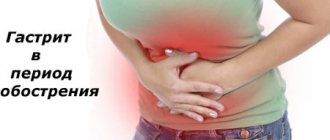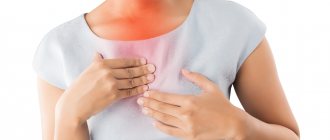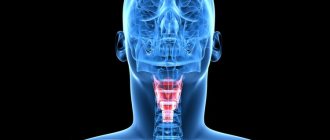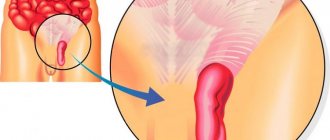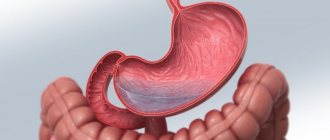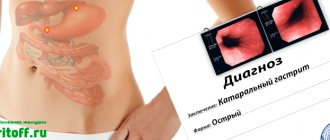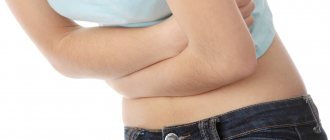Catarrhal bulbitis is a disease characterized by the occurrence of an inflammatory process in the duodenal bulb, which is located between the intestines and the stomach. There is no such ailment in the international classification of diseases, but doctors, for greater convenience, often distinguish this form. The main difference between this disorder and superficial bulbitis is that the symptoms are expressed over a long period of time.
- Etiology
- Symptoms
- Diagnostics
- Treatment
- Prevention
The main cause of this disorder is the pathological influence of the bacterium Helicobacter pylori, but in some cases the influence of Giardia and helminths is noted. There are several predisposing factors: poor nutrition, hereditary predisposition, low level of immunity and unhealthy lifestyle.
The main symptoms of the disease can be considered the occurrence of pain, heartburn, belching with an unpleasant odor, the appearance of an unpleasant odor in the mouth, as well as attacks of nausea and vomiting after eating. Diagnostic measures consist of laboratory tests and instrumental examinations of the patient. Treatment of catarrhal type bulbitis is based on taking medications, using traditional medicine and following a strict diet.
Etiology
The main factor of occurrence is considered to be the pathogenic influence of the microorganism. But doctors identify several favorable reasons against which the disease develops:
- errors in nutrition; prolonged fasting or, conversely, eating excessively fatty, spicy and salty foods;
- reduced level of the immune system;
- maintaining an unhealthy lifestyle, addiction to alcoholic beverages, drugs and smoking;
- hereditary predisposition;
- Hormonal imbalance is the main cause of the formation of focal catarrhal bulbitis.
This disease can occur in both acute and chronic forms, with periods of exacerbation. This entirely depends on timely initiation of complex treatment, as well as compliance with all recommendations of the attending physician.
Symptoms
The clinical expression of catarrhal bulbitis is similar to the signs of diseases of the duodenum and stomach. The main symptoms are:
- pain syndrome is the occurrence of acute or aching pain in the abdominal area. It often occurs on an empty stomach or at night. The pain can spread to the navel area and radiate to the shoulder blades. The intensity decreases after taking medications aimed at reducing acidity or after eating food;
- the appearance of an unpleasant odor and taste in the mouth;
- constant feeling of heartburn;
- belching with an unpleasant sour smell of recently eaten food;
- attacks of severe dizziness;
- impaired excretion of feces, manifested in constant constipation;
- increased sweating;
- vomiting after eating food, which very often leads to decreased pain;
- sleep disorders;
- weakness of the body, as a result of which a person’s performance decreases;
- increased irritability.
In some cases, patients complain of weakness and muscle tremors. Similar symptoms are characteristic of focal catarrhal bulbitis.
Diagnosis of bulbitis
Diagnosis of any type of duodenal bulbitis is not particularly difficult, since each form of inflammation has characteristic symptoms. The most important thing during diagnosis is to determine the degree of damage to the mucous membrane; for this, the following methods are used:
- fibrogastroduodenoscopy;
- X-ray of the stomach;
- Ultrasound.
In addition, the following are carried out:
- examining the patient and determining the intensity of expression of signs of the disease;
- general and biochemical blood test;
- laboratory tests of gastric juice;
- Breath test system to detect bacteria.
On examination, pale skin is observed with severe blood loss. When palpating the upper abdomen, pain occurs. There is a white coating on the tongue with teeth marks. A blood test shows changes that are non-specific for bulbitis: a decrease in red blood cells, hemoglobin (in the erosive version with bleeding), changes in the level of liver and pancreatic enzymes. A stool test is performed for occult blood. In order to confirm the presence of Helicobacter, a urease breath test, enzyme-linked immunosorbent assay, PCR, and examination of a biopsy specimen taken during endoscopy are performed.
Another method for diagnosing bulbitis is esophagogastroduodenoscopy, which allows you to visually assess the condition of the mucous membrane, identify erosions, determine the degree of damage and perform a biopsy. Carrying out radiography for bulbitis provides additional diagnostic opportunities. In addition, when diagnosing bulbitis, ultrasound of the abdominal organs can be used, which allows one to examine the liver and pancreas.
Diagnostics
This stomach disease requires complex diagnostics, which consists of laboratory and instrumental studies. Before prescribing them, the specialist must familiarize himself with the medical history of the patient and his immediate family. This is necessary to identify the causes of the formation of such a disorder, in particular hereditary predisposition. In addition, the doctor needs to find out the first time and intensity of symptoms, which are very often similar to peptic ulcers of the stomach and duodenum. If necessary, the patient is examined and the abdomen is palpated.
Laboratory studies of blood and urine tests are necessary to look for predisposing factors or associated disorders. Often this disease is accompanied by a change in the ratio of blood components. A laboratory test of gastric juice is also performed.
The basis of diagnostic measures for catarrhal bulbitis is:
- breath test to determine the presence of the bacterium Helicobacter pylori;
- EGD examination of the mucous membrane of the stomach and other organs of the digestive system using endoscopic instruments. During this procedure, a biopsy is performed, if necessary;
- survey radiography of the abdominal organs aimed at identifying disturbances in the interaction between the stomach and duodenum;
- Ultrasound examination of the digestive system;
- tests to determine the acidity of gastric juice.
After receiving all the results of the patient’s diagnostic examinations, the specialist confirms the diagnosis and draws up an individual treatment strategy.
Diagnostic methods
To make a diagnosis
“catarrhal bulbitis”, the doctor first conducts a conversation with the patient in order to clarify exactly what conditions are bothering him and how often, what intensity they have. After which the specialist conducts a direct examination of the patient by palpation, thereby identifying the localization of the inflammatory process. When pressing on the area of the duodenal bulb, the patient experiences severe pain.
But a doctor cannot make an accurate diagnosis based solely on his own feelings. He refers the patient to fibrogastroduodenoscopy, which allows to identify the presence of inflammatory processes in the upper part of the duodenum and stomach. The doctor also gives a referral for blood donation to determine the acidity level. Additionally, diagnostic methods such as ultrasound and CT can be used.
Only after receiving all the results of the patient’s examination, the doctor sees what it is, makes a diagnosis and determines further treatment tactics.
Treatment
In order to completely get rid of all manifestations of catarrhal bulbitis, complex therapy is prescribed, which consists of using medications, following a strict diet and using traditional medicine.
Drug treatment includes the prescription of substances aimed at:
- reducing the level of acidity in the stomach;
- elimination of the inflammatory process and pain syndrome;
- protection of the mucous membrane. Such drugs have an enveloping effect and prevent repeated pathological effects of Helicobacter pylori;
- elimination of the main causative agent of catarrhal bulbitis;
- strengthening the human immune system.
Diet therapy plays an important role in the treatment of this disorder. Basics of proper nutrition:
- exclusion from the diet of fatty foods, hot seasonings and sauces, smoked meats and pickles;
- fractional nutrition. You need to eat in small portions, six times a day;
- avoidance of vegetables containing coarse fiber;
- eat only first courses cooked in low-fat or vegetarian broth, or softened food.
In addition, it is necessary to stop drinking alcoholic beverages in any quantities and smoking tobacco.
For mild cases of the disease, complex treatment may include the use of traditional medicine. To do this, you need to take decoctions and infusions based on cloves, chamomile, wormwood, tansy, St. John's wort and flax seeds. Such components can be used separately or as part of an herbal mixture.
Treatment methods for bulboduodenitis
As with any other disease of the digestive tract, in the case of bulboduodenitis, the basis of treatment is diet.
All irritating foods (sour, spicy, salty, spicy, alcoholic drinks), strong tea and coffee, rich broths, herbs are completely excluded from the diet. Food that is too hot or, conversely, cold is also prohibited.
Among medications, depending on the specific situation, drugs are used to reduce the acidity of gastric contents, antibiotics (to fight Helicobacter pylori infection or protozoa), enveloping agents, as well as medications that accelerate the restoration of the mucous membrane.
Herbal medicine—the use of medicinal plants—has also become quite widespread in the treatment of bulboduodenitis.
The information provided is not a recommendation for the treatment of bulboduodenitis, but is a brief description of the disease for the purpose of familiarization. Do not forget that self-medication can harm your health. If signs of illness appear or are suspected, you should immediately consult a doctor. Be healthy.
Prevention
There is no specific prevention of catarrhal bulbitis. A person must adhere to general preventive rules, which include:
- maintaining a healthy lifestyle;
- timely treatment of diseases of the digestive system;
- diet;
- regular moderate exercise;
- undergoing examination by a specialist at least twice a year.
The prognosis for this disorder is favorable in most cases.
Features of the pathology
Bile products exit into the duodenal bulb. Here, the stomach contents are alkalized, mixed with bile and enzymes, and moved into the intestines for further digestion.
If the walls of an organ become inflamed and swollen, its patency decreases. The bolus of food begins to stagnate, the free release of enzymes and bile becomes difficult, all this further irritates the mucous membrane.
Reasons for the development of the disease
Experts say the main factor is infection of the body by Helicobacter pylori bacteria, which live in conditions of increased acidity of the gastric environment. In the vast majority of cases, it is these bacteria that provoke the development of chronic inflammatory diseases (gastritis, stomach ulcers).
In addition, possible reasons include:
- infection with parasites (giardia, helminths);
- Crohn's disease;
- mechanical or chemical damage to internal organs (injury from sharp pieces of food, foreign objects, toxic substances, thermal burns);
- unhealthy diet: long intervals between meals, alternating with overeating, strict restriction of food when losing weight, passion for spicy and fatty foods;
- alcohol and cigarette abuse;
- decrease in the body’s defenses (for example, as a result of previous diseases);
- genetic predisposition;
- individual structural features of the digestive tract, provoking increased mobility of the duodenum, which can twist into extra loops. In such areas, food stagnates, creating favorable conditions for the life of pathogenic microorganisms, which leads to complications.
Pathological changes manifest themselves as:
- swelling of the duodenum;
- inflammation of the mucous membrane;
- intestinal motility dysfunction;
- reflux (reflux of intestinal contents back into the stomach);
- inability to completely empty the stomach;
- dilation of blood vessels.
From the acute stage, the disease can become chronic with periods of relapses and remissions. In this case, the course of treatment will be longer.
Exacerbations are most often observed in spring and autumn, when a person’s immunity is especially subject to stress.
Stomach bulbitis symptoms
The duodenal bulb is located in the proximal part and is shaped like an ampulla. This is an important anatomical site that is involved in the movement of food from the epigastrium to the intestine.
The disease develops at any age. More often, gastric bulbitis develops in adults. Children suffer from the disease less often; this is most likely due to genetic predisposition. The chronic type of this disease leads to damage to this part of the duodenum with subsequent destruction. Symptoms of bulbitis depend on the clinical type. In this way, doctors are able to promptly determine the type of disease and begin treatment before diagnosis in order to prevent deterioration and complications.
- discomfort in the upper part of the peritoneum;
- nausea;
- vomiting, in severe cases with blood;
- belching after eating or between meals;
- during an exacerbation, body temperature rises;
- diarrhea begins and flatulence worries.
Sometimes bulbitis occurs in a hidden form. Many patients are unaware of the existence of the disease, and some symptoms are similar to diseases of the gastrointestinal tract, so it is difficult to independently differentiate the pathology. Bulbit is difficult to diagnose; more often, pathological conditions are discovered by chance during a gastrological or x-ray examination of the stomach.
This pathology can cause significant discomfort and prevents a person from living a full life. If you respond to the disease in a timely manner, you will be able to get rid of it completely. And if you follow preventive measures, you will be able to prevent a relapse.
Symptomatic picture
Bulbitis does not have any clear specific characteristics. The symptoms resemble common manifestations of a malfunction of the digestive system:
- pain in the pit of the stomach may radiate to the umbilical area, under the shoulder blade. Accompanied by a feeling of hunger. Most often they are dull, drawing in nature, but spasms are also likely and occur on an empty stomach, at night. They subside after eating or taking medications that reduce the acidity of digestive juice;
- heartburn, which is explained by damage to the esophageal mucosa due to acid reflux;
- belching sour or bitter, occurring every time after eating;
- unpleasant sensations in the oral cavity (bitterness, the appearance of a repulsive odor);
- nausea;
- vomiting, which relieves pain;
- bowel disorders (constipation);
- deterioration of general condition: weakness, muscle tremors, increased sweating, fatigue, insomnia, headaches, irritability.
The main instrumental method to confirm or refute the diagnosis is fibrogastroduodenoscopy (FGDS). During the examination, the diagnostician observes inflammation and swelling of the mucous membrane, bile stagnation, an uncharacteristic amount of cloudy mucus, enlarged capillaries, residual fluid a sign of incomplete emptying of the stomach.
The contents of the digestive organs are taken for analysis and the pH balance of the gastric environment is determined.
Treatment of catarrhal bulbitis
It will be possible to get rid of the disease if you strictly follow medical recommendations. The basis of recovery is proper nutrition, however, medications will also be needed to restore damaged bulb walls and normalize digestion.
Drug therapy
The main areas of influence will be fighting infection, reducing the acidity of gastric juice, normalizing peristalsis, protecting the walls of internal organs from the influence of negative factors:
- antibiotics are prescribed in case of proven presence of pathogenic microorganisms (Amoxicillin, Metronidazole, Sumamed). During antibacterial therapy, it is necessary to take probiotics that restore intestinal microflora (Linex, Bifidumbacterin);
- antacids are used to reduce the level of acidity (Rennie, Gastal, Maalox); painkillers (No-shpa, Baralgin, Papaverine) cope well with pronounced pain syndrome;
- Almagel and Phosphalugel have an enveloping effect;
- regeneration of damaged tissues of the stomach and duodenum is promoted by De-nol, Dalargin, Gastrofarm, sea buckthorn oil;
- vitamin complexes and immunomodulators will help a weakened body regain strength;
- sedatives (tinctures of motherwort, valerian, preparations based on other herbal components) are used in the treatment of patients susceptible to stress.
Medicines are prescribed by the doctor depending on the clinical picture of the disease and the individual characteristics of the body (age, previous diseases, allergic reactions). You cannot take pills on your own without first consulting a specialist!
Recommended Diet
You will have to limit yourself in many ways for a long time in order not only to relieve the signs of the inflammatory process, but also to give the internal organs time to fully recover.
For the first one or two days, therapeutic fasting is indicated under the supervision of a doctor. It may be necessary to rinse the stomach with a solution of manganese and the intestines with a solution of magnesium sulfate.
Basic nutrition rules:
- frequent split meals (5-6 times a day) in small, equal-sized portions at the same time of day;
- dishes must be cooked using steam or water; At first, the food should be liquid or well ground. In any case, all food must be chewed thoroughly;
- the temperature of the food eaten should approximately correspond to the temperature of the human body: too hot and too cold dishes irritate the mucous membranes;
- pickles and marinades, canned food, smoked meats, spicy and fatty foods, confectionery, and baked goods are prohibited;
- it is necessary to monitor the amount of salt and spices consumed; they should be kept to a minimum in dishes;
- products containing coarse plant fiber (legumes, raw vegetables, especially cabbage, radishes, carrots, garlic, onions) are excluded from the diet;
- We recommend low-fat meat and vegetable broths, boiled meat or steamed cutlets (suitable varieties such as beef, veal, rabbit, chicken, turkey), vegetable stews and casseroles;
- It is better to additionally chop cereals before preparing porridge (buckwheat, oatmeal, rice, semolina);
- on the recommendation of a doctor, you can also supplement the treatment by taking warm mineral water Essentuki No. 4 on an empty stomach, from which you must first release gases.
The sooner you give up bad habits (alcohol, coffee, cigarettes, fast food and soda), the faster you will notice an improvement in your health!
Folk remedies
Non-traditional methods can be used as an addition to the main treatment after the doctor's approval.
The most popular and effective are:
- oak bark decoction has anti-inflammatory and analgesic effects. Pour 20 grams of raw material into a glass of water and boil for a quarter of an hour. Next, the drink must be infused for another hour, then strained. Take a glass before meals;
- Mix plantain juice with honey in proportions of 50 ml per 1 tsp. respectively. Eat 1 large spoon before meals;
- St. John's wort 2 tbsp. raw materials are poured with a glass of boiling water and left for 1 hour. Take a quarter glass before meals;
- freshly squeezed carrot juice is drunk half an hour to 40 minutes before meals, 50-70 ml;
- herbal mixture of marshmallow + licorice root + chamomile flowers + St. John's wort mixed in equal proportions (2 tablespoons of each herb). For half a liter of boiling water, take 2 tablespoons of the resulting herbal mixture. Leave in a thermos overnight. Drink warm 3 times a day half an hour before meals.
Treatment of bulbitis
Complex treatment of bulbitis is carried out by a gastroenterologist, in case of complications of the disease - by a surgeon, and a diet is necessarily prescribed. If the cause of the disease is parasites, then it is necessary to conduct a course of anthelmintic therapy. In addition, the patient should lead a healthy lifestyle: moderate physical activity, giving up bad habits. Stomach diseases are largely influenced by a person’s psycho-emotional state, so it is necessary to work on oneself, increase stress resistance and protect oneself from negative experiences.
Drug treatment of bulbitis
The basis of drug therapy is the destruction of the pathogen; the following are prescribed:
- anti-Helicobacter antibiotics: amoxicycline, vilprafen, summed, de-nol;
- proton pump inhibitors;
- bismuth preparations.
To reduce the acidity of gastric juice, use:
- antacids;
- M-anticholinergics;
- H2-histamine blockers.
To restore the mucous membrane, use:
- rosehip oil;
- sea buckthorn oil;
- Actovegin;
- solcoseryl;
- dalargin.
And agents that increase mucus production:
- liquorice root;
- biogastron;
- Liquiriton.
If the patient suffers from pain, then medications from the group of antispasmodics and anticholinergics are prescribed:
- no-shpa;
- baralgin;
- atropine
When an acute form of bulbitis occurs, it is necessary to take antacids that quickly neutralize the acid component and stop the development of the process, which provides quick relief to the general condition of the sick person:
- Almagel;
- gastal;
- Maalox;
- Rennie.
Physiotherapeutic treatment of bulbitis
Physiotherapy for bulbitis includes magnetic therapy, electrophoresis with analgesics and antispasmodics (novocaine, papaverine, zinc sulfate on the epigastric area involving the pyloroduodenal zone). The use of mud, paraffin and ozokerite applications shows good results. Outside the period of exacerbation, patients should undergo sanatorium-resort treatment using mineral waters twice a year. Herbal medicine for bulbitis includes the use of fees, which include:
- celandine;
- chamomile;
- yarrow;
- St. John's wort;
- fennel;
- Linden.
Recommended use of mineral waters:
- Esentuki No. 4, No. 17;
- "Borjomi".
Surgical treatment of bulbitis
Surgical treatment of bulbitis with ulcers consists of surgical intervention, the purpose of which is parasympathetic denervation of the gastroduodenal zone and reduction of hydrochloric acid production. Trunk vagotomy (the entire stomach is denervated) or selective proximal vagotomy (the acid-producing zone is denervated) can be used. Emergency surgical intervention consists of stopping bleeding by clipping or ligating bleeding vessels during gastroduodenoscopy. If endoscopy does not reveal the source of bleeding, duodenotomy and suturing of the duodenal ulcer are performed.
Folk remedies for treating bulbitis
In some cases, folk remedies that increase the body's immunity can cope with bulbitis. Erosive or acute bulbitis is treated by fasting for several days, with bed rest and taking herbal decoctions. With chronic bulbitis, it is necessary to lead a healthy lifestyle, avoid stress, do not smoke, do not drink alcohol and eat right. Food should be crushed and consumed in small portions; you should eat natural products.
Anthelmintics
If bulbitis is caused by parasites, you should take tinctures and decoctions of herbs that have antiparasitic properties:
- carnation,
- tansy,
- wormwood.
Anti-inflammatory drugs
- Plantain juice mixed with honey has an anti-inflammatory effect: take plantain grass, squeeze out the juice, 3 tbsp. mix juice with 1 tsp. natural honey.
- Infusion of chamomile and moss: take 1 tbsp. Icelandic moss and chamomile, pour 400 g. boiling water, let it brew for 1 hour. Take 1/2 cup 3 times a day before meals.
- Infusion of licorice root, marshmallow root, St. John's wort and chamomile: take the herbs in equal parts, chop, mix, pour 400 grams. hot water and place in a dark place to infuse for 12 hours. Take warm throughout the day and always before bed.
- Decoction of oak bark. Take 1/2 cup before meals.
Prevention
Despite the long recovery process, the disease is treatable. And by following some rules of prevention, you can avoid disorders in the digestive system:
- adhere to the rules of healthy eating: eat at the same time, do not overeat, do not get carried away with flour, spicy, salty, fried foods;
- do not forget about personal hygiene;
- try to avoid bad habits: coffee, smoking, alcohol;
- follow the doctor’s prescriptions for diseases of the gastrointestinal tract, after completing the treatment course, contact a specialist again to conduct tests for the presence of the causative agent of the disease;
- after recovery, attend preventive examinations;
- regularly visit the dentist and promptly treat inflammations and infections of the oral cavity; do not resort to self-medication: use medications only after consultation with a doctor;
- avoid mental and emotional stress.
Causes of manifestation
Factors provoking catarrhal bulbitis are pathological deviations that manifest themselves in refusal of a healthy lifestyle. The main source of the inflammatory process is Helicobacter, but both Giardia and helminths can provoke it.
The main causes of catarrhal bulbitis:
- Certain violations in the diet and diet: fasting for weight loss, long breaks between meals. Eating fried and fatty foods, as well as adding a variety of marinades to the menu.
- Smoking and drinking alcoholic beverages.
- Reduced immunity.
- Predisposition and heredity.
Symptoms
The manifestation of the disease is similar to diseases of the duodenum or stomach:
- The pain is characteristically aching or similar in type to contractions. Often the pain begins to manifest itself at night or on an empty stomach, is localized in the pancreas, radiates to the shoulder blade and navel. Unpleasant pain can also begin after taking medications that are intended to normalize acidity in the stomach, or after eating any food.
- Nausea and spontaneous vomiting after eating relieve pain.
- Unpleasant and irritating odor in the mouth and bitterness.
- Severe heartburn and unpleasant belching of food eaten. This occurs due to the reflux of acidic contents in the stomach directly into the affected esophagus.
Periodically, hunger pains can be accompanied by severe weakness and trembling in muscle tissue. The following common symptoms are also observed: irritability, sweating, severe and unexpected fatigue, headaches, disruption of sleep patterns, which affects ability to work.
During an accurate diagnosis, the doctor can detect swelling of the folds, expansion of capillaries, residual fluid in the stomach cavity, cloudy mucus, and bile reflux. These signs allow you to establish an accurate diagnosis and prescribe effective treatment that will help you recover.
Symptoms of bulbitis
This disease is characterized by certain manifestations that indicate the presence of catarrhal bulbitis. By the frequency and duration of symptoms, you can learn about the severity of the disease and the degree of its development.
If any signs appear, you must consult a doctor and undergo a full medical examination, because the disease develops quickly and can cause complications.
The most common symptoms of the disease are:
- pain in the stomach and epigastric region is the main sign that catarrhal bulbitis of the stomach is forming; the pain can be of a different nature and duration depending on the severity of the disease and its course;
- a feeling of nausea and vomiting often appears immediately after eating or after some time;
- constipation occurs due to impaired digestive function, because inflammatory processes occur and the entire gastrointestinal tract is involved;
- frequent heartburn, belching after eating.
Recognizing the symptoms is very important, as they help to detect the disease in a timely manner and prevent its further development.
Treatment
To cure catarrhal bulbitis, you must very painstakingly and carefully follow all the recommendations aimed at regimen and nutrition.
The diet is based on the restrictions that are established for peptic ulcers. There should be about six meals a day, in small portions. Get used to boiled or steamed foods. Smoking and drinking any alcoholic beverages is prohibited. Prolonged consumption of coarse fiber, which is found in cabbage and radishes, is prohibited.
For active and effective treatment in modern medicine, many well-known methods are used:
- Antacids, which can significantly reduce the acidity of gastric fluid.
- Preparations with an enveloping effect that helps protect the mucous membrane.
- Medicines to significantly reduce inflammation.
- Many doctors prefer short-term, but effective therapy with antibiotics.
Many experts strongly recommend consuming a lot of vitamins during the treatment of catarrhal bulbitis. Also relevant will be immunocorrectors, which will help increase immunity and all the active protective functions of the body.
Avoiding a relapse of the disease is possible if you follow all the recommendations prescribed by your doctor. Remember that the unconditional success of treatment directly depends on how quickly you contact a specialist with complaints and conduct a thorough diagnosis of your condition.
What is catarrhal bulbitis of the stomach?
In order to understand what catarrhal gastric bulbitis is, it is necessary to understand that this is one of the forms of pathological processes that arise in the upper part of the duodenum. The location of the follicles of the upper intestine is localized at the border of the transition between the stomach and intestines.
Inflammation of the duodenal bulb can occur for many reasons, therefore, in order to avoid possible complications, it is necessary to consult a gastroenterologist at the first symptoms of the disease.
If this rule is not followed, there is a high risk of focal bulbitis transitioning to the chronic stage with spread to other parts of the digestive tract.
The development of inflammatory processes in the area where the duodenal bulbs are located is characterized by edematous phenomena of the mucous membrane with further disruption of the outflow of specific secretions. This can lead to stagnation of bile and a decrease in enzymatic activity.
General information about the disease
The International Classification of Diseases (ICD) does not include such a disease as bulbitis. However, many doctors use this term to characterize the processes occurring in the duodenum and stomach.
In the upper part of the duodenum, which is affected by bulbitis, there are ducts of the gallbladder. With inflammation, their functionality decreases, which leads to disruption of the release of bile. Its stagnation also causes other diseases that can even threaten human life.
Various factors can provoke inflammatory processes in the duodenal bulb. The most common of them are:
- abuse of fatty, fried and spicy foods;
- hereditary predisposition;
- inflammatory gastrointestinal pathologies;
- injuries to the gastrointestinal tract caused by impact, bruise or surgery;
- damage to the duodenum by bacteria of the genus Helicobacter pylori;
- frequent adherence to hungry diets;
- long periods of time between meals;
- alcohol and tobacco abuse.
alcohol abuse
smoking abuse
Depending on which factor provoked the development of inflammatory processes, bulbitis is divided into:
- chronic;
- erosive;
- follicular;
- catarrhal
The development of catarrhal bulbitis is associated with the impact on the gastrointestinal tract of one or more of the above-mentioned factors. But, as practice shows, in most cases its occurrence is associated with damage to the mucous bulb by parasitic microorganisms, which include:
- Giardia;
- helminthic infestations;
- Helicobacter.
And if we talk about what catarrhal bulbitis is, then it can be characterized as follows: a disease that develops over a long time and manifests itself in periodic attacks. Moreover, unlike chronic bulbitis, catarrhal attacks occur extremely rarely.
Causes of pathology
Catarrhal bulbitis of the stomach in most cases occurs due to exposure of the mucous membrane of the digestive tract to the infectious agent of the bacterium Helicobacter pylori.
This type of pathogenic microorganisms can affect not only the stomach, but also cause inflammatory processes in the duodenal bulbs.
The basic reasons for the development of the disease are:
In addition, this disease has its own classification of types:
It is possible that a pathological process may develop due to helminthic infestations, giardiasis and Helicobacter.
Therapeutic measures
Catarrhal bulbitis can be cured using an integrated approach, which involves the use of medications.
The main treatment for catarrhal bulbitis is as follows:
- Antibiotics (Amoxicillin, Sumamed, Metronidazole) - help destroy and eliminate pathogenic microorganisms. Used for 7-10 days along with medications that improve intestinal microflora.
- Reparants - relieve spasms and inflammatory processes in the bulb.
- Antacids (Maalox, Rennie, Gastal) - they are intended for taking medications that normalize stomach acidity. They are considered symptomatic drugs and can alleviate a person’s condition.
- Sedatives - they contain plant components that allow you to increase the body’s resistance to stressful situations, since they are a factor in the aggravation of bulbitis.
- Enveloping – protect the mucous membrane and destroy pathogenic bacteria.
- Immunocorrectors – help strengthen the body after treatment with antibiotics.
The prescription of the drug occurs on an individual basis, because drugs can only be treated depending on the severity of the disease and the presence of associated ailments.
Treatment of catarrhal bulbitis
This type of inflammatory pathological process is not easy to treat. To treat catarrhal bulbitis, it is necessary to spend a sufficient amount of time.
If characteristic signs of the disease occur, it is important to contact a specialist in time for qualified help. The basis of therapy is taking medications and adjusting the diet.
An important point for successful treatment of the disease is proper dietary nutrition and strict adherence to meal schedules.
It is worth paying attention to the fact that catarrhal bulbitis of the focal type is treated with medications, and in advanced cases, surgical intervention is performed.
Drug treatment
Before prescribing medications, the doctor must conduct a diagnosis to identify the stage of bulbitis. Drug treatment includes taking the following types of medications:
- Antacids Gastal, Rennie, Maalox. This group of drugs helps bring the acidity level of gastric juice to a normal physiological state.
- Antibiotics Metronidazole, Vilprafen, Sumamed, Amoxicillin. During the diagnostic process, the cause of catarrhal bulbitis can be identified: the bacterium Helicobacter pylori. In this case, you cannot do without antimicrobial drugs.
- Antiemetic medications.
- Painkillers Baralgin, Papaverine, No-shpa. This group of medications will help relieve spasms and reduce the tone of muscle fibers in the digestive tract.
Surgery
Surgery is prescribed in case of ulcerative lesions of the mucous membrane of the duodenum and stomach. The goal of this treatment is to deinnervate the transition zone between the stomach and the small intestine and reduce the production of hydrochloric acid. In such cases, truncal vagotomy or proximal vagotomy is used.
Nutrition and diet
Dietary nutrition for catarrhal bulbitis in the acute phase involves a period of complete fasting and a period of rest. This will reduce the secretion of gastric juice and avoid an increase in acidity in the gastrointestinal tract.
Next, you need to adhere to a special diet for at least 30 days, which has similar rules to the treatment of gastritis:
A pathological process such as gastric bulbitis must be treated in a hospital under the supervision of the attending physician. This is necessary so that, if necessary, medical personnel can install an IV if pain occurs with eating, and carry out additional diagnostic methods.
Don’t forget about special immunocorrector drugs. They will allow you to quickly restore the immune strength of the human body and prevent the return of the disease.
Sources:
- https://OkGastro.ru/dvenadtsatiperstnaya/47-kataralnyj-bulbit
- https://bolvzheludke.ru/zabolevanija/kataralnyj-bulbit/
- https://gastroved.com/kataralnyj-bulbit.html
- https://BolitVnutri.ru/zabolevaniya-zheludka/bulbitis/kataralnyj-bulbit-zheludka-chto-eto-takoe/
What to do
Systematic use of painkillers for bulbitis, as in other similar cases, does not solve the problem, but only transfers the disease to a new stage, which may be final. Prolonged hunger, night pain in the pit of the stomach should be a reason for an examination.
Basic aspects of drug treatment
The content of the treatment regimen depends on the etiology and prevalence of bulbitis, which has taken on a catarrhal form, concomitant chronic diseases, laboratory test data, age and even the psychotype of the patient. The presence of inflammatory foci suggests protection of the mucous membrane with specific enveloping drugs, as well as:
- prescribing appropriate anti-inflammatory drugs and prokinetics;
- correction of the acidity of gastric secretions, prescription of sedatives, replenishment of enzyme deficiency - according to indications.
In case of a parasitic infection that could potentially aggravate the course of the disease, anthelmintic therapy is carried out.
Dietary Requirements
Nutrition for catarrhal bulbitis involves switching to a so-called gentle diet that can provide a person with all the necessary set of nutrients. At the same time, food must undergo processing that ensures minimal digestion effort and induce a healthy appetite - the key to abundant natural secretion of digestive enzymes.
Traditional medicine
Treatment of catarrhal bulbitis is a long and difficult process. Its course can be significantly alleviated by any folk remedies if they have a wound-healing or bactericidal effect. But their use must be agreed with the attending physician, as there are risks of incompatibility with medications and allergic reactions, especially when using plant materials.




